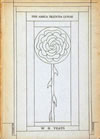
BL. W. B. Yeats
 |
13. Per Amica Silentia Lunae. London: Macmillan, 1918.
Yeats’s prose explanation of, among other things, a belief in ghosts, and a statement of ontological ‘conviction’ that underlies his later dramatic theory. The work explicitly draws upon the ontology of the mugen nô, particularly the Pound/Fenollosa NISHIKIGI (BK8) and Stopes’s MOTOMEZUKA (see D23), to advance the thesis that the spirits of the dead ‘dream back’ their passions in the world of the living. The work that most explicitly gives dramatic voice to understandings outlined here—and which in the Yeats canon is most closely modelled on the ‘nô of ghosts’—is The Dreaming of the Bones (14a), though no Yeatsian drama written after 1916 is untouched by the system of belief outlined in this work, and the concept of the dreaming back of the dead occupies Yeats for the remainder of his life: see, especially, Calvary (17a), The Words Upon the Window Pane (34), ‘The Soul in Judgment’ in A Vision (38b, and see also 57), and Purgatory (44b). ‘Anima Hominis’ is dated 25 February, ‘Anima Mundi’, 9 May, 1917. See also BK27, 56a 183, BL14a, 15a, 38, 38b, 38b2, 123, and 193. Reprinted in 23 and in Mythologies (London: Macmillan, 1959).

